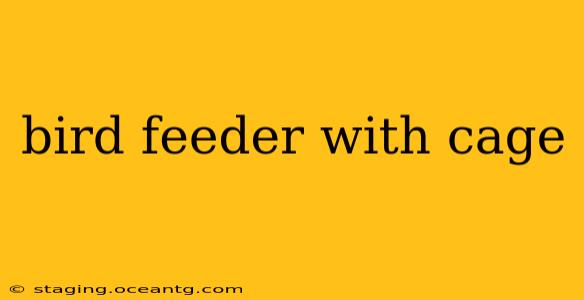Attracting birds to your garden is a rewarding experience, offering delightful entertainment and contributing to local biodiversity. However, providing a bird feeder also brings a responsibility: protecting your feathered friends from predators. A bird feeder with a cage offers a crucial solution, safeguarding your birds while allowing them easy access to food. This comprehensive guide will explore the benefits, different types, and considerations for choosing the perfect caged bird feeder for your backyard.
What are the benefits of a bird feeder with a cage?
The primary benefit of a caged bird feeder is predator protection. Squirrels, cats, raccoons, and even larger birds can easily raid unprotected feeders, leaving smaller birds without food and potentially causing injury or death. A cage creates a physical barrier, preventing these unwelcome guests from accessing the seeds or suet. This ensures that the birds you intend to feed actually benefit from your efforts. Beyond predator protection, some caged feeders offer additional benefits such as:
- Weather protection: Some cages offer partial shielding from rain and snow, keeping the food dry and preventing spoilage.
- Reduced mess: Cages help to contain spilled seeds, keeping your patio or deck cleaner.
- Increased feeding area: Some designs offer multiple feeding stations within the cage, accommodating more birds simultaneously.
What are the different types of caged bird feeders?
There's a wide variety of caged bird feeders available, each with its unique design and features. The most common types include:
- Wire-mesh cages: These are the most common type, offering excellent visibility and ventilation. They are usually easy to clean and relatively inexpensive.
- Plastic cages: Plastic cages offer good protection but can sometimes be more difficult to clean. They may also be less durable than wire cages.
- Tube feeders with cages: These combine the convenience of a tube feeder with the protection of a cage, often with multiple feeding ports.
- Suet feeders with cages: These are specifically designed to hold suet cakes or blocks, providing a high-energy food source protected from predators.
What size cage should I choose for my bird feeder?
The size of the cage you choose depends on the size and type of birds you wish to attract, as well as the size of the feeder itself. A cage that's too small will restrict access for larger birds, while a cage that's too large might not offer sufficient protection. Consider the following:
- Bird species: Smaller birds require smaller openings in the cage to prevent larger birds from accessing the food.
- Feeder size: The cage should be large enough to comfortably enclose the feeder without restricting access for the intended birds.
- Predator prevalence: In areas with particularly aggressive predators, a larger, sturdier cage may be necessary.
How do I clean a caged bird feeder?
Regular cleaning is essential to prevent the spread of disease among your feathered visitors. Clean your caged bird feeder at least once a month, or more frequently in warm, humid weather. Remove all food and debris, and wash the cage and feeder with warm, soapy water. Rinse thoroughly and allow to dry completely before refilling. Avoid using harsh chemicals.
Where should I place a caged bird feeder?
Placement is crucial for maximizing bird activity and minimizing predator access. Consider the following:
- Height: Place the feeder at a height that is accessible to your target birds, but out of reach of ground predators like cats and raccoons.
- Visibility: Choose a location that offers clear visibility for the birds, allowing them to easily spot the feeder and feel safe from ambush.
- Shelter: Position the feeder near some form of cover, such as shrubs or trees, providing the birds with a safe escape route.
- Accessibility: Ensure the feeder is easily accessible for cleaning and refilling.
What kind of birdseed is best for a caged feeder?
The type of birdseed you choose will depend on the species of birds you hope to attract. Black oil sunflower seeds are a popular choice, as they are a favorite of many bird species and are high in energy. Other options include nyjer seed for finches, and suet for woodpeckers and other birds that require high-fat diets. Avoid using moldy or spoiled seeds.
By understanding the benefits, types, and placement considerations of a bird feeder with a cage, you can create a safe and inviting haven for your backyard birds, allowing you to enjoy their vibrant presence while protecting them from unwanted predators. Remember to maintain your feeder regularly for a healthy and thriving bird population.
